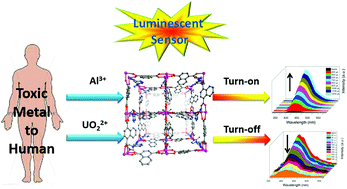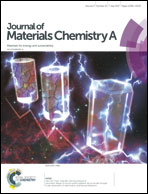A superior fluorescent sensor for Al3+ and UO22+ based on a Co(ii) metal–organic framework with exposed pyrimidyl Lewis base sites†
Abstract
A robust 3D pcu Co(II) metal–organic framework (MOF) based on a designed bent pyrimidyl–biimidazole ligand, [Co2(dmimpym)(nda)2]n (1; dmimpym = 4,6-di(2-methyl-imidazol-1-yl)-pyrimidine, H2nda = 1,4-naphthalenedicarboxylic acid), was successfully synthesized under solvothermal conditions and characterized using single-crystal X-ray diffraction. Compound 1 has a 2-fold interpenetrated 6-connected pcu network based on a [Co2(COO)4] paddle-wheel secondary building unit (SBU). It contains exposed pyrimidyl Lewis base sites, has porosity, and exhibits ligand-based blue emission in the solid state, which render it suitable as a fluorescent sensor for the detection of metal ions. Fluorescence titration experiments reveal that 1 is highly selective for Al3+ with exclusively enhanced emission as compared to other metal ions, and the limit of detection (LOD) reaches as low as 0.7 μM. Importantly, 1 can be cycled at least five times without the loss of emission signals. Moreover, 1 is able to detect low concentration of uranyl ions via fluorescence quenching. The present study sheds light on the realization of the practical application of MOFs as luminescent sensors via tailoring of the ligand and extends the way towards low-cost transition metal-based MOF sensors.



 Please wait while we load your content...
Please wait while we load your content...